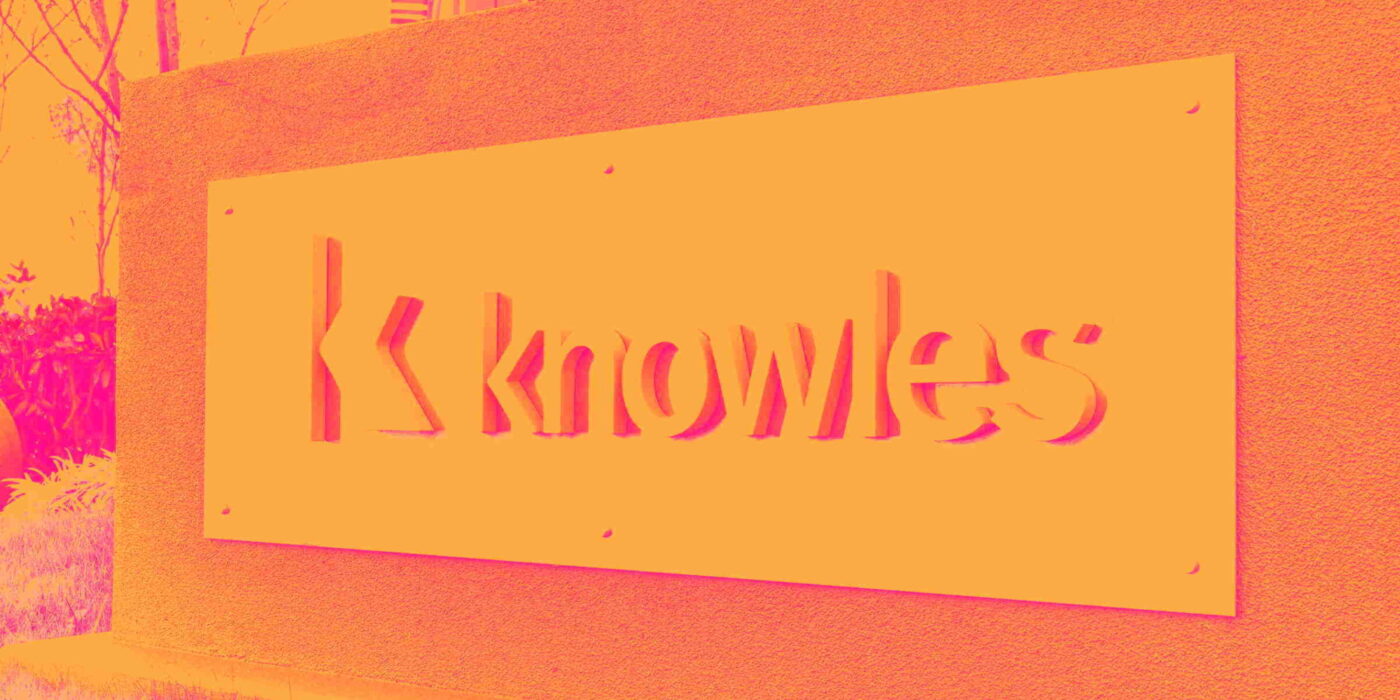
Acoustic component provider Knowles (NYSE: KN) missed Wall Street’s revenue expectations in Q4 CY2024, with sales falling 33.8% year on year to $142.5 million. Next quarter’s revenue guidance of $129 million underwhelmed, coming in 5.5% below analysts’ estimates. Its non-GAAP profit of $0.27 per share was 4.4% below analysts’ consensus estimates.
Is now the time to buy Knowles? Find out by accessing our full research report, it’s free.
Knowles (KN) Q4 CY2024 Highlights:
- Revenue: $142.5 million vs analyst estimates of $146 million (33.8% year-on-year decline, 2.4% miss)
- Adjusted EPS: $0.27 vs analyst expectations of $0.28 (4.4% miss)
- Adjusted EBITDA: $34.7 million vs analyst estimates of $36.6 million (24.4% margin, 5.2% miss)
- Revenue Guidance for Q1 CY2025 is $129 million at the midpoint, below analyst estimates of $136.5 million
- Adjusted EPS guidance for Q1 CY2025 is $0.18 at the midpoint, below analyst estimates of $0.22
- Operating Margin: 10.8%, in line with the same quarter last year
- Free Cash Flow Margin: 21.3%, down from 25.7% in the same quarter last year
- Market Capitalization: $1.59 billion
“With the successful completion of the divestiture of the Consumer MEMS Microphone business at the end of 2024, we took another significant step to further the Company’s strategic transformation into a premier industrial technology company focusing on higher value markets,” said Jeffrey Niew, President and CEO of Knowles.
Company Overview
Holding a swath of patents, Knowles (NYSSE:KN) offers acoustics components for various industries.
Electronic Components
Like many equipment and component manufacturers, electronic components companies are buoyed by secular trends such as connectivity and industrial automation. More specific pockets of strong demand include data centers and telecommunications, which can benefit companies whose optical and transceiver offerings fit those markets. But like the broader industrials sector, these companies are also at the whim of economic cycles. Consumer spending, for example, can greatly impact these companies’ volumes.
Sales Growth
Reviewing a company’s long-term sales performance reveals insights into its quality. Any business can have short-term success, but a top-tier one grows for years. Knowles’s demand was weak over the last four years as its sales fell at a 2.7% annual rate. This fell short of our benchmarks and is a sign of poor business quality.
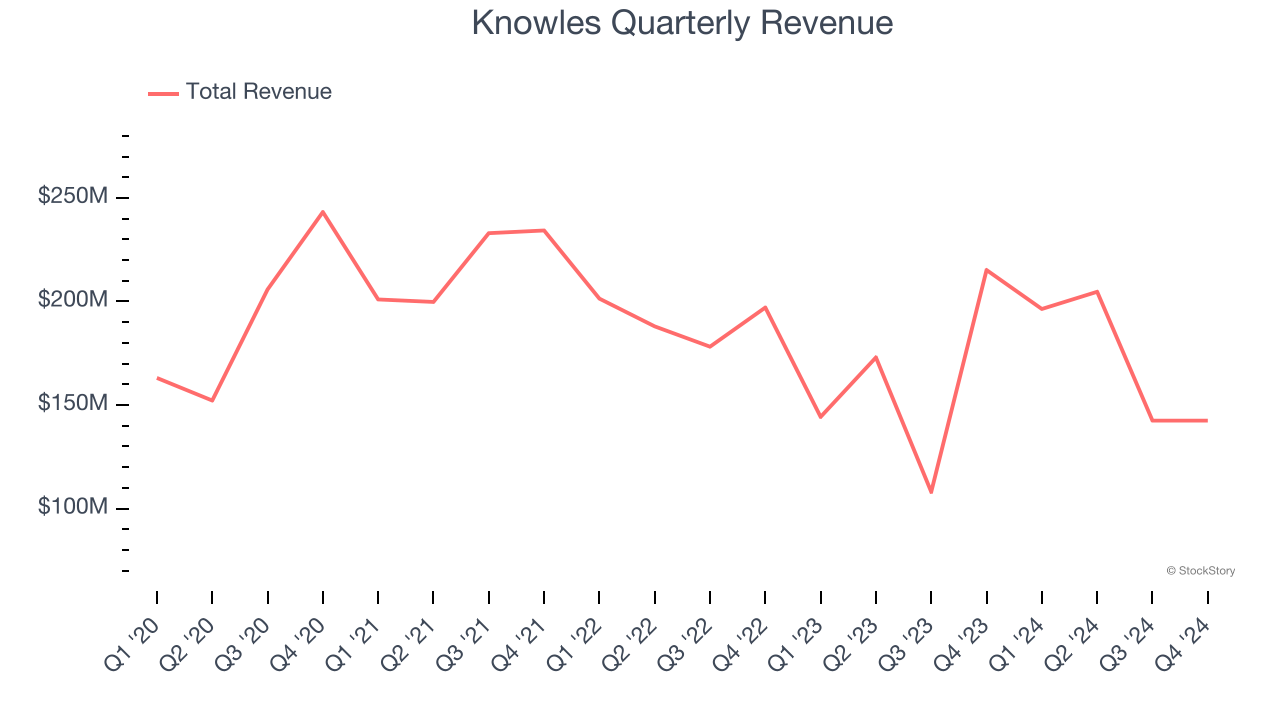
We at StockStory place the most emphasis on long-term growth, but within industrials, a stretched historical view may miss cycles, industry trends, or a company capitalizing on catalysts such as a new contract win or a successful product line. Knowles’s recent history shows its demand has stayed suppressed as its revenue has declined by 5.3% annually over the last two years. 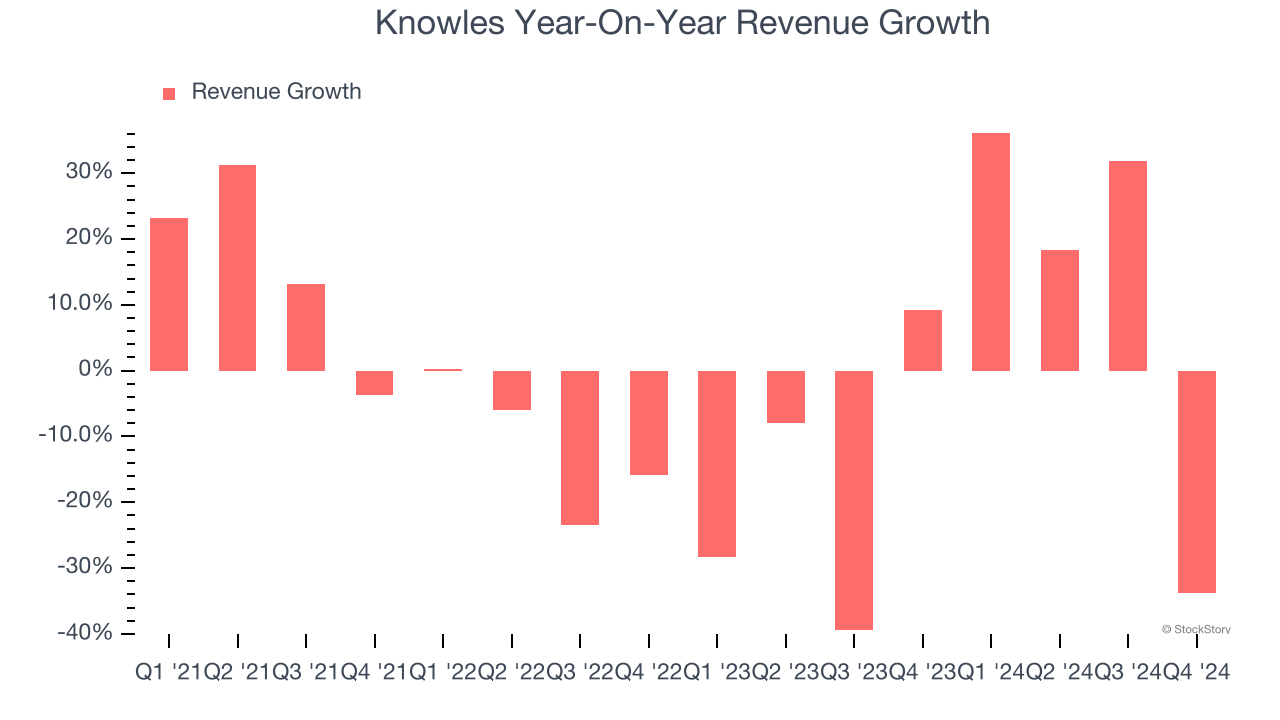
This quarter, Knowles missed Wall Street’s estimates and reported a rather uninspiring 33.8% year-on-year revenue decline, generating $142.5 million of revenue. Company management is currently guiding for a 34.3% year-on-year decline in sales next quarter.
Looking further ahead, sell-side analysts expect revenue to decline by 14.3% over the next 12 months, a deceleration versus the last two years. This projection is underwhelming and indicates its products and services will see some demand headwinds.
Unless you’ve been living under a rock, it should be obvious by now that generative AI is going to have a huge impact on how large corporations do business. While Nvidia and AMD are trading close to all-time highs, we prefer a lesser-known (but still profitable) stock benefiting from the rise of AI. Click here to access our free report one of our favorites growth stories.
Operating Margin
Operating margin is one of the best measures of profitability because it tells us how much money a company takes home after procuring and manufacturing its products, marketing and selling those products, and most importantly, keeping them relevant through research and development.
Knowles has managed its cost base well over the last five years. It demonstrated solid profitability for an industrials business, producing an average operating margin of 10.1%. This result isn’t surprising as its high gross margin gives it a favorable starting point.
Analyzing the trend in its profitability, Knowles’s operating margin rose by 1.8 percentage points over the last five years, showing its efficiency has improved.
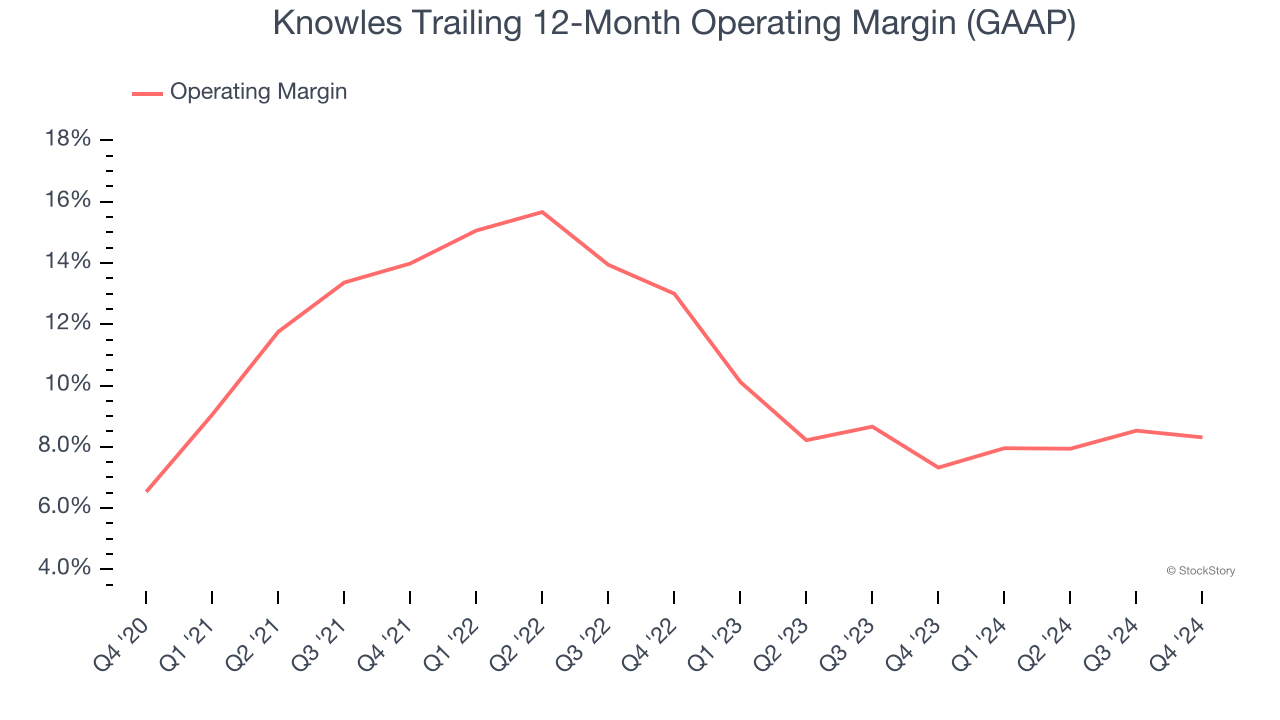
This quarter, Knowles generated an operating profit margin of 10.8%, in line with the same quarter last year. This indicates the company’s cost structure has recently been stable.
Earnings Per Share
We track the long-term change in earnings per share (EPS) for the same reason as long-term revenue growth. Compared to revenue, however, EPS highlights whether a company’s growth is profitable.
Knowles’s full-year EPS dropped 11.1%, or 2.1% annually, over the last five years. We tend to steer our readers away from companies with falling revenue and EPS, where diminishing earnings could imply changing secular trends and preferences. If the tide turns unexpectedly, Knowles’s low margin of safety could leave its stock price susceptible to large downswings.
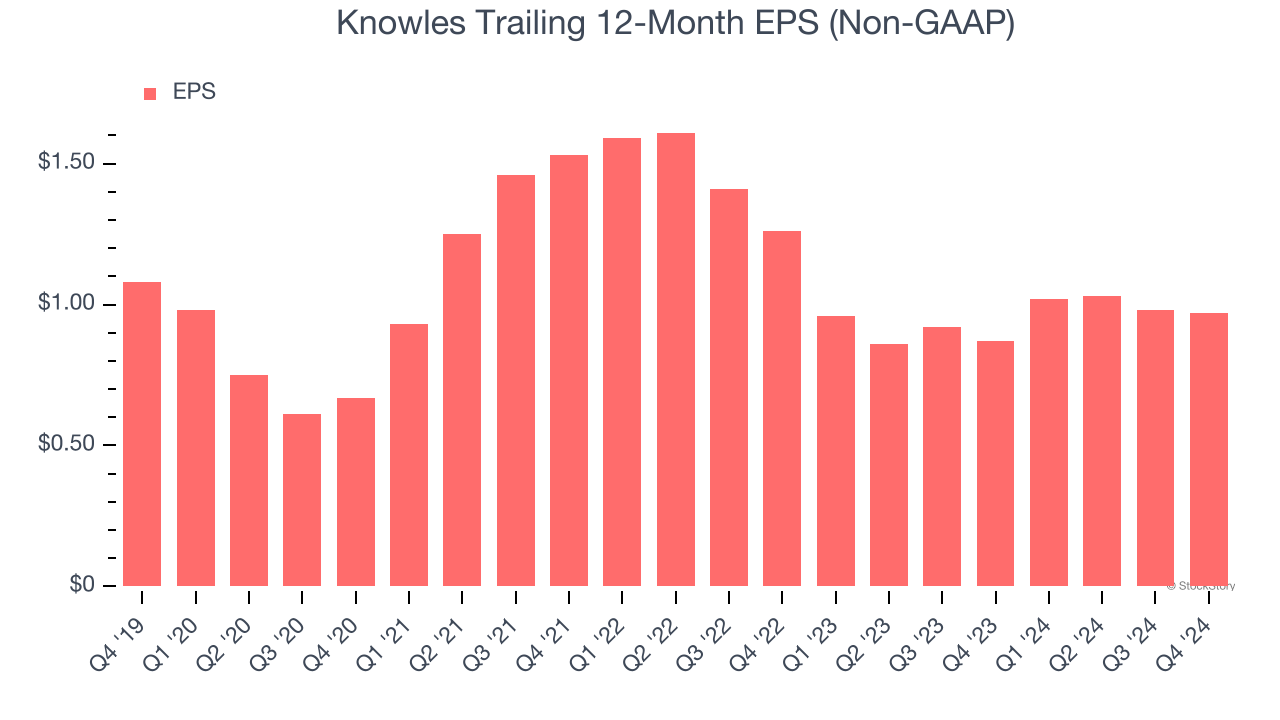
Like with revenue, we analyze EPS over a more recent period because it can provide insight into an emerging theme or development for the business.
Sadly for Knowles, its EPS declined by more than its revenue over the last two years, dropping 12.3%. This tells us the company struggled to adjust to shrinking demand.
Diving into the nuances of Knowles’s earnings can give us a better understanding of its performance. While we mentioned earlier that Knowles’s operating margin was flat this quarter, a two-year view shows its margin has declined by 4.5 percentage points. This was the most relevant factor (aside from the revenue impact) behind its lower earnings; taxes and interest expenses can also affect EPS but don’t tell us as much about a company’s fundamentals.
In Q4, Knowles reported EPS at $0.27, down from $0.28 in the same quarter last year. This print missed analysts’ estimates. Over the next 12 months, Wall Street expects Knowles’s full-year EPS of $0.97 to grow 14.2%.
Key Takeaways from Knowles’s Q4 Results
We struggled to find many positives in these results. Its revenue guidance for next quarter missed significantly and its revenue fell short of Wall Street’s estimates. Overall, this was a softer quarter. The stock traded down 10% to $16.42 immediately following the results.
Knowles underperformed this quarter, but does that create an opportunity to invest right now? The latest quarter does matter, but not nearly as much as longer-term fundamentals and valuation, when deciding if the stock is a buy. We cover that in our actionable full research report which you can read here, it’s free.






